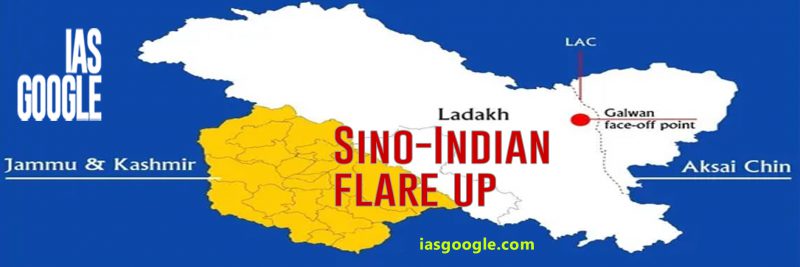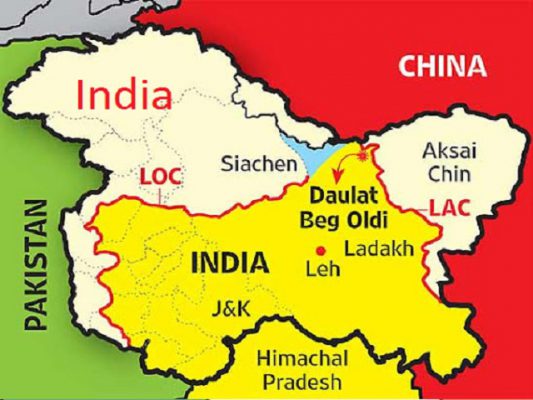- Home
- Prelims
- Mains
- Current Affairs
- Study Materials
- Test Series
Sino - Indian Galwan flare-up
Galwan River and Valley are of strategic interest to both India and China. The latest skirmishes on the LAC emerge from China’s hegemonistic tendencies and desire to keep India away from Xinjiang-Tibet highway.
 Recently, 20 Indian Army personnel, including the Commanding Officer of 16th Bihar Regiment, lost their lives at the hands of Chinese troops in the Galwan Valley of Ladakh.
This was an unprovoked attack by the Chinese border troops on Indian soldiers, after confirming the implementation of the de-escalation plan by the Chinese in Galwan valley. The plan of de-escalation is based on a phased withdrawal of troops to their respective predetermined ground positions, were decided on June 6 during the corps commanders-level talks.
The incident represents a watershed in India’s relations with China and marks the end of a 45-year chapter which saw no armed confrontation involving loss of lives on the Line of Actual Control (LAC).
Issue
Recently, 20 Indian Army personnel, including the Commanding Officer of 16th Bihar Regiment, lost their lives at the hands of Chinese troops in the Galwan Valley of Ladakh.
This was an unprovoked attack by the Chinese border troops on Indian soldiers, after confirming the implementation of the de-escalation plan by the Chinese in Galwan valley. The plan of de-escalation is based on a phased withdrawal of troops to their respective predetermined ground positions, were decided on June 6 during the corps commanders-level talks.
The incident represents a watershed in India’s relations with China and marks the end of a 45-year chapter which saw no armed confrontation involving loss of lives on the Line of Actual Control (LAC).
Issue


There is no clear cut demarcation at the LAC that is why standoffs have taken place many times like; Doklam in 2017,Chumar in 2014, Depsang in 2013 and Sumdorong Chu in 1987.
The same kind of situation exists at the LOC where Pakistan army using POK regions to send terrorists in India.
Road Ahead
 Recently, 20 Indian Army personnel, including the Commanding Officer of 16th Bihar Regiment, lost their lives at the hands of Chinese troops in the Galwan Valley of Ladakh.
This was an unprovoked attack by the Chinese border troops on Indian soldiers, after confirming the implementation of the de-escalation plan by the Chinese in Galwan valley. The plan of de-escalation is based on a phased withdrawal of troops to their respective predetermined ground positions, were decided on June 6 during the corps commanders-level talks.
The incident represents a watershed in India’s relations with China and marks the end of a 45-year chapter which saw no armed confrontation involving loss of lives on the Line of Actual Control (LAC).
Issue
Recently, 20 Indian Army personnel, including the Commanding Officer of 16th Bihar Regiment, lost their lives at the hands of Chinese troops in the Galwan Valley of Ladakh.
This was an unprovoked attack by the Chinese border troops on Indian soldiers, after confirming the implementation of the de-escalation plan by the Chinese in Galwan valley. The plan of de-escalation is based on a phased withdrawal of troops to their respective predetermined ground positions, were decided on June 6 during the corps commanders-level talks.
The incident represents a watershed in India’s relations with China and marks the end of a 45-year chapter which saw no armed confrontation involving loss of lives on the Line of Actual Control (LAC).
Issue
- The Indian and Chinese armies are engaged in the standoff in Pangong Tso, Galwan Valley, Demchok and Daulat Beg Oldie in eastern Ladakh.
- A sizable number of Chinese Army personnel even transgressed into the Indian side of the de-facto border in several areas including Pangong Tso.
- The actions on the northern bank of Pangong Tso are not just for territorial gains on land, but enhanced domination of the resource-rich lake.
- The stand-off at Ladakh’s Galwan Valley has escalated in recent weeks due to the infrastructure projects that India has undertaken in the recent years. India is building a strategic road through the Galwan Valley - close to China - connecting the region to an airstrip.
- China is opposed to any Indian construction in the area. In 1962, a stand-off in the Galwan area was one of the biggest flashpoints of the 1962 war.
- The border, or Line of Actual Control, is not demarcated, and China and India have differing ideas of where it should be located, leading to regular border “transgressions.” Often these don’t escalate tensions; a serious border standoff like the current one is less frequent, though this is the fourth since 2013.
- Both countries’ troops have patrolled this region for decades, as the contested 2,200-mile border is a long-standing subject of competing claims and tensions, including a brief war in 1962.
- Reasons:The violent clash happened when the Chinese side departed from the consensus to respect the LAC and attempted to unilaterally change the status quo.
- It is part of China’s‘nibble and negotiate policy’. Their aim is to ensure that India does not build infrastructure along the LAC. It is their way of attaining a political goal with military might, while gaining more territory in the process.
- The LAC is the demarcation that separates Indian-controlled territory from Chinese-controlled territory. India considers the LAC to be 3,488 km long, while the Chinese consider it to be only around 2,000 km.
- The India-China LAC in Ladakh is an outcome of the territory illegally retained by China after the 1962 conflict. The Chinese occupation of parts of Aksai Chinis not supported by historical or legal documents.
- It is divided into three sectors:
- the eastern sector which spans Arunachal Pradesh and Sikkim
- the middle sector in Uttarakhand and Himachal Pradesh
- the western sector in Ladakh
- The Galwan Valley areacomes under Sub Sector North (SSN), which lies just to the east of the Siachen glacier and is the only point that provides direct access to Aksai Chin from India.
LAC .vs. LOC
LOC or Line of Control is a live line with a lot of activities like firing and face to face interaction. It is clearly demarcated by the militaries. It denotes a kind of boundary separating parts of Indian UT i.e. Jammu & Kashmir; controlled by India and illegally occupied by Pakistan. The length of LOC is around 776-kilometers. Indian part (southern and eastern parts of the region) of LOC is known as Jammu and Kashmir which constitutes about 45 percent of Kashmir. LAC LAC stands for Line of Actual Control. It is a boundary between China and India. The concept of “Line of Actual Control” (LAC) came in a bilateral agreement in 1993, although there was no concrete settlement on ground positions between these two countries. The LAC separates Indian-controlled territory from Chinese-controlled territory. It is a big empty region and nearly 50 to 100 kms distance is maintained by the armies of India and China. The Chinese government considers LAC to be around 2,000 km while India considers the LAC to be 3,488 km long. LAC is divided into three regions: the western sector in Ladakh, the middle sector in Uttarakhand and Himachal Pradesh, and the eastern sector which spans Arunachal Pradesh and Sikkim.

| Comparison | LOC | LAC |
| Location | Three areas of Kashmir (Azad Kashmir, Gilgit and Baltistan)occupied by Pakistan and two-thirds, Jammu, Ladakh, and the Kashmir Valley, administered by India.(although whole Kashmir is an integral part of India) | It is scattered in three areas of northern Indian states: eastern (Sikkim, Arunachal Pradesh), western (Ladakh, Kashmir), and middle (Uttarakhand, Himachal Pradesh). |
| Appearance | It is clearly demarcated by the militaries and a lot of activities (face to face confrontation, firings, etc) take place. Indian and Pakistan army is present here. | These are big empty regions and nearly 50 to 100 km distance is maintained between Indian and Chinese armies. |
| Area (Length) | 776 kilometer (unofficial) | 4,057 kilometer (unofficial) |
| Between | India and Pakistan | India and China |
- Devolution of comprehensive China strategy:Strong political direction, mature deliberation and coherence are keys to handling the situation.
- The Army can make tactical adjustments and manoeuvres to deter the Chinese, but a comprehensive China strategy and its determination should devolve on those tasked with national security policy in the highest echelons of the Government of India.
- Strategic communication:The responsibility of effective strategic communication too rests with political leadership. It is important to perceive the signals of transgressions on a serious note and adopt adequate strategy with clear instructions for forces.
- Clarification on LAC:India should take the initiative to insist on a timely and early clarification of the LAC. Pockets of difference of alignment as perceived by each side have to be clearly identified and these areas demilitarised by both sides through joint agreement pending a settlement of the boundary.
- Diplomatic channels must continue to be open and should not be fettered in any way because their smooth operability is vital in the current situation.
- Scaling down of military contact:India must stand resolute and firm in the defence of territory in all four sectors of the border. Contacts between the two militaries through joint exercises and exchanges of visits of senior Commanders should be scaled down for the foreseeable future.
- Counterbalance for the outside world:India’s leverage and balancing power within the Indo-Pacific and the world beyond stems from its strong democratic credentials, the dynamism of its economy, its leading role in multilateral institutions.
- The strategic advantageof its maritime geography is an asset possessed by few nations, and which must be deployed much more effectively to counterbalance the Chinese ingress into this oceanic space that surrounds us.
- Reconsider RCEP engagement:The time has also come for India to reconsider its stand on joining the Regional Comprehensive Economic Partnership.
- If India is to disengage from economic involvement with China, and build the capacities and capabilities it needs in manufacturing, and in supply chains networks closer home, it cannot be a prisoner of the short term.
- It is time to boldly take the long view in this area as also on its South Asia policy.









 Latest News
Latest News
 General Studies
General Studies